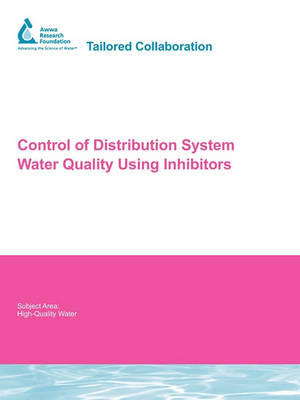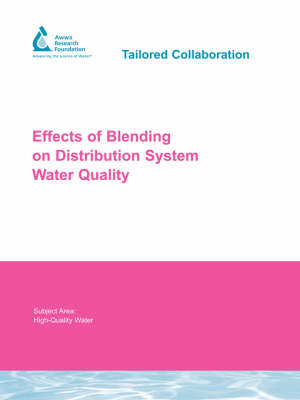Water Research Foundation Report
2 total works
Control of Distribution System Water Quality Using Inhibitors
by J. Taylor, J. Dietz, A. Randall, C. Norris, A. Alshehri, J. Arevalo, X. Guan, P. Lintereur, D. MacNevin, and E Stone
Published 13 September 2009
Tampa Bay Water (TBW) manages a number of city and county drinking water resources and has recently had to use finished waters produced from saline and surface water sources to supplement their groundwater supplies. Drinking water utilities in Florida and similar environments have historically relied on groundwater, but overreliance on the source has led to the pursuit of other multiple sources. Finished water quality varies by source and the effects of corrosion inhibitors on distribution water quality are unknown. Hence, the capabilities of corrosion inhibitors to offset the adverse effects of changing finished water quality on distribution system water quality needs to be investigated.
This study was conducted to investigate the capabilities of corrosion inhibitors (orthophosphate (OP), zinc orthophosphate (ZOP), blended ortho-polyphosphate (BOP), silicate, or pH only inhibition) to offset the adverse effects of changing finished water quality on distribution system water quality. Eighteen PDS's and two pilot treatment systems were used for this project. The 14 hybrid PDS's from four different pipe materials were used for the inhibitor study while the other four single material lines were used to investigate the effect of turbulence on chloramine decay.
Twelve thousand gallons of conventionally treated groundwater and desalinated groundwater from the two pilot processes on site and from the TBW regional surface water treatment plant were used each week. Water was blended at predetermined ratios and distributed to the PDS's. BOP, OP, ZOP, silicate inhibitors, and NaOH (pH only) were added to the PDS's. Phosphate inhibitors were dosed at 0.5, 1, and 2 mg/L as P; silicate inhibitors were dosed at 3, 6, and 12 mg/L as SiO2; and two PDS's were maintained at pHs and pHs+0.3. Physical, chemical, and biological changes were monitored throughout the PDS's. This work has shown that inhibitor addition was necessary to control Fe, Cu, and Pb release in high alkalinity finished water and provide a higher water quality to consumers. Models relating EN to Fe, Cu, and Pb release predicted metal release as accurate, less costly, and more rapid than water quality models. Inhibition addition did not affect chloramine residual but was shown to increase biological activity in distribution systems.
This study was conducted to investigate the capabilities of corrosion inhibitors (orthophosphate (OP), zinc orthophosphate (ZOP), blended ortho-polyphosphate (BOP), silicate, or pH only inhibition) to offset the adverse effects of changing finished water quality on distribution system water quality. Eighteen PDS's and two pilot treatment systems were used for this project. The 14 hybrid PDS's from four different pipe materials were used for the inhibitor study while the other four single material lines were used to investigate the effect of turbulence on chloramine decay.
Twelve thousand gallons of conventionally treated groundwater and desalinated groundwater from the two pilot processes on site and from the TBW regional surface water treatment plant were used each week. Water was blended at predetermined ratios and distributed to the PDS's. BOP, OP, ZOP, silicate inhibitors, and NaOH (pH only) were added to the PDS's. Phosphate inhibitors were dosed at 0.5, 1, and 2 mg/L as P; silicate inhibitors were dosed at 3, 6, and 12 mg/L as SiO2; and two PDS's were maintained at pHs and pHs+0.3. Physical, chemical, and biological changes were monitored throughout the PDS's. This work has shown that inhibitor addition was necessary to control Fe, Cu, and Pb release in high alkalinity finished water and provide a higher water quality to consumers. Models relating EN to Fe, Cu, and Pb release predicted metal release as accurate, less costly, and more rapid than water quality models. Inhibition addition did not affect chloramine residual but was shown to increase biological activity in distribution systems.
Tampa Bay Water (TBW) manages drinking water resources for the cities of New Port Richey, St. Petersburg, and Tampa, and Hillsborough, Pasco, and Pinellas counties, all in the state of Florida. Groundwater had been historically utilized for drinking water supply; however, adverse environmental impacts have mandated that alternative sources (desalinated seawater and treated surface water) be used now. Although all delivered water met contractual requirements that exceeded those specified in the SDWA, the quality was not constant, hence a project to determine the effects of blended waters on the regional distribution system water quality was conducted. The primary project objective was to determine the effects of blending finished waters produced from ground, surface, and saline sources on distribution system water quality. For this project, the effects were determined by the corresponding iron release, copper release, lead release, biological stability, residual maintenance, biological nitrification, and transition of iron, copper, and lead following changes in distribution system water quality due to blending.

